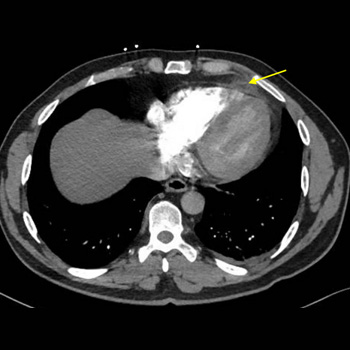Keywords
Epipericardial fat necrosis, chest pain, COVID-19, epipericardial adipose tissue
Abstract
Background: Epipericardial fat necrosis (EFN) is a rare and self-limiting cause of acute chest pain. We describe a case of EFN in a patient with a recent coronavirus disease (COVID-19).
Case Presentation: A 55-year-old male presented with a sudden onset of left-sided pleuritic chest pain for the past two days. The patient was diaphoretic, tachypneic, and tachycardic. Acute coronary syndrome was ruled out. A computed tomography (CT) pulmonary angiogram revealed an ovoid encapsulated fatty mass surrounded by dense appearing tissue. Patient symptoms improved remarkably with a short course of non-steroidal anti-inflammatory drugs (NSAIDs).
Discussion: EFN typically presents with a sudden onset of excruciating chest pain. Misdiagnosis, under-diagnosis, and mismanagement are unavoidable. EFN is incidentally diagnosed on CT scan. Severe acute respiratory syndrome coronavirus 2 (SARS-CoV-2) infects visceral adipose tissue and appears to increase the risk of EFN by promoting inflammatory cytokine production and death of adipocytes.
Conclusion: EFN is a rare cause of acute chest pain. SARS-CoV-2 is likely to induce EFN. This rare clinical entity should be considered in the differential of acute chest pain especially in patients with active or recent COVID-19.
References











